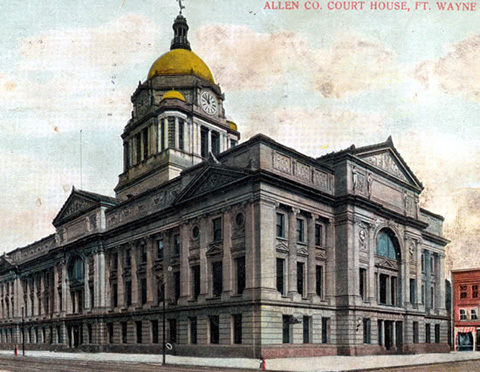 Enyeart has looked beyond taking photos of the state's courthouses, and into the structure and history of them. He has over 3,000 pictures of 200 different Indiana courthouses and drawings of 50 more. He also has over 1,000 Indiana Courthouse postcards, which he brought with him.
Enyeart has looked beyond taking photos of the state's courthouses, and into the structure and history of them. He has over 3,000 pictures of 200 different Indiana courthouses and drawings of 50 more. He also has over 1,000 Indiana Courthouse postcards, which he brought with him.
He noted that there were 15 courthouses standing in Indiana before the territory became a state in 1816. Most of the early courthouses, including Pulaski County’s first one, were log structures.
Enyeart explained there were many reasons why Indiana’s counties built such elaborate courthouse structures, and added jokingly that no county can brag about having such a magnificent building, because “every county has one!”
One of the prime reasons for building such massive, sturdy courthouses was to have a fireproof place for storing important county records. Another reason was to provide large courtrooms, because in early days the public eagerly attended trials. Almost all courthouses had bell towers, and the bells were rung when a jury returned with a verdict so the public could be called back to hear it,” Enyeart said.
“Courthouses were also the official timekeepers,” he added, noting almost all have clocks because few had wristwatches in early days. Courthouses also housed the public restrooms for downtown shoppers and others doing business in town. In addition they provide public meeting places.
Then there was the little matter of “county-to-county competition to build showplaces,” Enyeart said. Many of these buildings reflect community pride and even commissioners’ egos.
Since it was first settled, Indiana has had 339 courthouses and 115 of these are standing today. The current Pulaski County courthouse was built in 1895, and was preceded by two other courthouses.
Enyeart discussed the architects and architectural styles of the state’s courthouses, most of which were built in the late 1800s and early 1900s. Over the years a few have been destroyed by fire, one by a tornado, and others have been renovated or “modernized,” often with unfortunate results. Enyeart said that in many counties, historical societies have stepped forward to save or protect courthouses. The last new one built was in 1976.
The state’s “courthouse of courthouses,” according to Enyeart, is the Allen County Courthouse in Fort Wayne, built in 1902 and designed by Brentwood Tolan.
Membership Drive, New Officers and Directors
The Historical Society is conducting a membership drive, and warmly encourages anyone who might be interested in joining to attend the annual meeting. Dues for the Society are $25 a year. A new corporate membership has been introduced and is available for $75 annually. Participation in the Society can be as involved as each individual member chooses, but membership will directly impact the preservation of the history of Pulaski County for years to come.
Officers elected at the meeting were president Steve Morrison, vice president Kathi Thompson, secretary Mackenzie Ledley and treasurer Lin Morrison. Directors elected or re-elected were Natalie Federer, Alex Haschell, Janet Onken. Karen Fritz. Brian Ledley, Jane Rausch, Mary Conner, Jack Krasner and Judy Heater. Ex-officio members are past president Chris Smith and county historian Lynda Irving.
The carry-in dinner meeting was held at the Pulaski County Public Library, Winamac.







